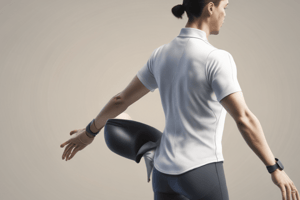Podcast
Questions and Answers
What is the function of the Parietal Bone?
What is the function of the Parietal Bone?
Protects the brain.
What is the function of the Occipital Bone?
What is the function of the Occipital Bone?
Forms the back of the skull.
What does Atlas (C1) refer to?
What does Atlas (C1) refer to?
The first cervical vertebra.
What does Atlas (C2) refer to?
What does Atlas (C2) refer to?
What is the Spinous Process of Thoracic Vertebra?
What is the Spinous Process of Thoracic Vertebra?
What defines a Thoracic Vertebra?
What defines a Thoracic Vertebra?
What are Floating Ribs?
What are Floating Ribs?
What is the Humerus?
What is the Humerus?
What is the Ulna?
What is the Ulna?
What is the Radius?
What is the Radius?
What are Carpal Bones?
What are Carpal Bones?
What is the Ischial Tuberosity?
What is the Ischial Tuberosity?
What are Phalanges?
What are Phalanges?
What are Metatarsal Bones?
What are Metatarsal Bones?
What is the Calcaneus?
What is the Calcaneus?
What is the Talus?
What is the Talus?
What is the Fibula?
What is the Fibula?
What is the Femoral Condyle?
What is the Femoral Condyle?
What is the Femur?
What is the Femur?
What are Metacarpal Bones?
What are Metacarpal Bones?
What is the Pubis?
What is the Pubis?
What is the Coccyx?
What is the Coccyx?
What is the Sacrum?
What is the Sacrum?
What is the Ilium?
What is the Ilium?
What is the Lumbar Vertebra?
What is the Lumbar Vertebra?
What is a False Rib?
What is a False Rib?
What is a True Rib?
What is a True Rib?
What is the Scapula?
What is the Scapula?
What is the Acromion?
What is the Acromion?
What is the Spine of the Scapula?
What is the Spine of the Scapula?
What is the Clavicle?
What is the Clavicle?
What is the Mandible?
What is the Mandible?
What is the Tibia?
What is the Tibia?
What is the Zygomatic Bone?
What is the Zygomatic Bone?
Flashcards are hidden until you start studying
Study Notes
Skeletal System
-
Parietal Bone: Forms the sides and roof of the cranium, protecting the brain.
-
Occipital Bone: Located at the back of the skull, contains the foramen magnum for spinal cord passage.
-
Atlas (C1): The first cervical vertebra, supports the skull, allows nodding motion.
-
Axis (C2): The second cervical vertebra, has the odontoid process (dens) enabling rotation of the head.
-
Spinous Process of Thoracic Vertebra: Projects posteriorly; attachment site for muscles and ligaments.
-
Thoracic Vertebra: Twelve vertebrae connecting to ribs, accommodating thoracic cavity structures.
-
Floating Ribs: The last two pairs of ribs; not attached to the sternum, providing flexibility.
-
Humerus: The upper arm bone, articulates with the scapula and radius.
-
Ulna: The inner forearm bone, larger at the elbow end; forms the elbow joint.
-
Radius: The outer forearm bone, allows rotation of the wrist joint.
-
Carpal Bones: Eight wrist bones; facilitate a wide range of hand movements.
-
Ischial Tuberosity: The bony prominence of the ischium; supports weight when sitting.
-
Phalanges: The bones of the fingers and toes; each digit has three (two in the thumb/big toe).
-
Metatarsal Bones: Five long bones in the foot; provide structure and support for the toes.
-
Calcaneus: The heel bone; largest tarsal bone, essential for walking and standing.
-
Talus: The ankle bone, articulates with the tibia and fibula.
-
Fibula: The outer leg bone; provides stability to the ankle joint.
-
Femoral Condyle: The rounded ends of the femur that articulate with the tibia at the knee joint.
-
Femur: The thigh bone; the longest and strongest bone in the body, supports body weight.
-
Metacarpal Bones: Five bones in the hand connecting wrist to fingers, essential for hand function.
-
Pubis: Part of the pelvic bone, located at the front, contributes to the pelvis's structure.
-
Coccyx: Known as the tailbone, formed by four fused vertebrae, supports pelvic organs.
-
Sacrum: A triangular bone made of five fused vertebrae at the base of the spine, connects to hips.
-
Ilium: The largest part of the pelvis, forms the hip bone, and provides attachment for muscles.
-
Lumbar Vertebra: Five vertebrae in the lower back; support upper body weight and allow flexibility.
-
False Rib: Ribs 8-10; indirectly connected to the sternum via cartilage.
-
True Rib: Ribs 1-7; directly attached to the sternum, providing respiratory structure.
-
Scapula: The shoulder blade; connects the humerus with the clavicle and provides shoulder mobility.
-
Acromion: The lateral extension of the scapula; forms a bony prominence of the shoulder.
-
Spine of the Scapula: A ridge along the back of the scapula, muscle attachment site.
-
Clavicle: The collarbone; connects the arm to the trunk, aids in shoulder mobility.
-
Mandible: The lower jawbone; the only movable bone of the skull, crucial for chewing.
-
Tibia: The shinbone; larger and stronger than the fibula, supports body weight.
-
Zygomatic Bone: The cheekbone; contributes to the structure of the face and orbit.
Studying That Suits You
Use AI to generate personalized quizzes and flashcards to suit your learning preferences.




